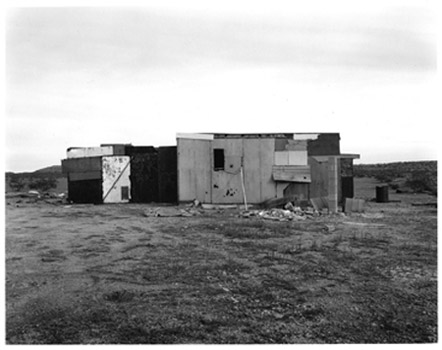
Lurking behind every discourse on ruins is nineteenth-century Romanticism with its melancholic musings on the transitory nature of life and civilization. For contemporary artists such as Mark Ruwedel, who for years has been photographically documenting the natural and cultural histories of the American West through such imagery as abandoned railway paths, the task is in repositioning that dialogue into the present. Three distinct groups of photographs, all modest-to-small-sized gold-toned gelatin silver and silver chloride prints, collectively titled Now It Is Dark, were shot in exurban Southern California desert locations such as the Antelope and Imperial Valleys. In the larger series, abandoned and unfinished mid-century homes in various stages of decay are all situated middle ground and center-framed, portrait-like and iconic. All are captured in an atmospheric twilight that ironically recalls Ansel Adams' transcendent light, but here connotes a waning or finality to Adams' era of unspoiled nature, much as the surrounding desiccating climate contributes to the sense of exhaustion. Several of the works, such as Antelope Valley #293A, with its fading painted plywood and corrugated metal sheets neatly organized into strict geometries, read as parodies of utopian High Modernist architecture. Participating in the sort of "ghost-town aesthetic" characteristic of Western mythology and its filmic representations, distant silhouetted mountains, decapitated palms, shriveled shrubs, twisted trees, tumbleweeds, windblown bags, peeling paint, windblown shingles, bullet riddled walls, mattresses and other trash cast a deathly, eerie pall over the sites. A group of smaller photographs focuses on single articles of clothing: bras, boots, corsets partially covered with earth, and slowing decomposing back into the dust, remain only clues and props to the mystery of the inhabitants' disappearance.
In his implications of sublimity in human powerlessness over mortality and natural forces, Ruwedel is a Neo-Romantic. He succeeds in raising more contemporary critical questions in addressing the notions of infinite plenitude and the resulting waste that drive the American economy, issues that were largely absent for the Romantics. Encountering these images of the American Dream in disarray and chaos, and the West as a terrain of unbridled land speculation and growth via the pursuit of unfettered individual gratification, we are confronted head-on with a "darkening" of the American Dream. Disrupting these obsolete myths of progress will occur not by obliterating, but by preserving, as Ruwedel has done, the traces of the carnage.
This article was written for and published in art ltd. magazine ![]()
